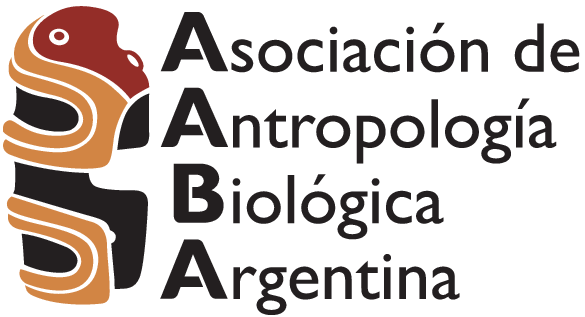Variabilidad de las proporciones molares en poblaciones humanas: un abordaje empleando modelos del desarrollo y experimentales / Variability of molar proportions in human populations: insights from developmental models and experiments in mice
Resumo
Los datos sobre la variación dental interpoblacional y sobre los mecanismos que regulan el desarrollo dental aportados por estudios experimentales aún no han sido integrados en el contexto de investigaciones antropobiológicas. En este sentido, el presente trabajo se propone: a) evaluar la consistencia entre la variación de las proporciones molares en poblaciones humanas que exhiben gran variación en el tamaño dental con las predicciones derivadas de un modelo de desarrollo dental de cascada inhibitoria, y b) analizar el efecto de los factores sistémicos que controlan el crecimiento del organismo sobre las proporciones de los molares inferiores empleando cepas de Mus musculus. Se calcularon las áreas de los molares inferiores mediante los diámetros bucolingual y mesiodistal. La variación interpoblacional en las proporciones M2/M1 y M3/M1 fue concordante con las expectativas derivadas del modelo y la mayoría de los grupos exhibieron una tendencia a la reducción del tamaño en sentido antero-posterior. Asimismo, se observó una asociación significativa y positiva entre el área molar total y las proporciones molares. En los modelos experimentales la alteración del crecimiento por factores sistémicos (subnutrición proteica y reducción de la hormona de crecimiento) resultó en la disminución del área molar total y cambios en las proporciones molares. Estos últimos, consistentes con el incremento del efecto inhibitorio en sentido antero-posterior. En conjunto, los resultados sugieren que la modificación de los factores sistémicos que regulan el área molar total podría conducir a cambios en la proporción de activadores-inhibidores y contribuir a la diferenciación interpoblacional en las proporciones molares.
Palabras clave: Modelo de cascada inhibitoria; tamaño dental; aproximación experimental y comparativa
Data on dental variation among human populations and the mechanisms regulating tooth development elucidated by experimental studies have not yet been integrated in the context of biological anthropology. In this sense, this paper proposes: a) to evaluate the consistency between changes in molar proportions in human populations that exhibit a wide variation in tooth size and the predictions derived from an inhibitory cascade model of dental development, and b) to analyze the effect of the systemic factors controlling the growth of the organism on the lower molars proportions using strains of Mus musculus. The crown area of the mandibular molars was estimated from the bucco-lingual and mesio-distal diameters. The results obtained for human populations showed that the pattern of variation in molar proportions is consistent with expectations derived from the inhibitory cascade model and that most groups exhibit a general trend towards molar size reduction in the antero-posterior direction. Also, a significant positive association between the total molar area and the molar ratios M2/M1 and M3/M1 was observed. In the experimental models, growth alteration caused by systemic factors (protein subnutrition and reduced growth hormone) resulted in a reduction of total molar area associated with changes in molar proportions. The latter are consistent with an increased antero-posterior inhibition. Overall, these results suggest that alterations in the systemic factors that control molar area can produce changes in the proportion of activators and inhibitors, and contribute in turn to inter-population differentiation in molar proportions.
Keywords: Inhibitory cascade model; dental size; experimental and comparative approach
Downloads
Referências
Arthur W. 2002. The emerging conceptual framework of evolutionary developmental biology. Nature 415:757-764 doi:10.1038/415757a
Asahara M. 2013. Unique inhibitory cascade pattern of molars in canids contributing to their potential to evolutionary plasticity of diet. Ecol Evol 3: 278-285. doi:10.1002/ece3.436
Bernal V, Perez SI, Gonzalez PN, Diniz-Filho JAF. 2010a. Ecological and evolutionary factors in dental morphological diversification among modern human populations from southern South America. Proc Biol Sci 277:1107-1112. doi:10.1098/rspb.2009.1823
Bernal V, Perez SI, Gonzalez PN, Sardi ML, Pucciarelli HM. 2010b. Spatial patterns and evolutionary processes in southern South America: a study of dental morphometric variation. Am J Phys Anthropol 142:95-104. doi: 10.1002/ajpa.21206.
Bernal V, Gonzalez PN, Perez SI. 2013. Developmental processes, evolvability, and dental diversification of new world monkeys. J Evol Biol. doi:10.1007/s11692-013-9229-4
Brace CL, Rosenberg KR, Kevin DH. 1987. Gradual change in human tooth size in the late Pleistocene and postPleistocene. Evolution 41:705-720.
Brace CL, Smith SL, Hunt KD. 1991. What big teeth you had grandma! Human tooth size, past and present. En: Kelley MA, Larsen CS, editors. Advances in Dental Anthropology. New York: Wiley-Liss, Inc. p 33-57.
Butler PM. 1939. Studies of the mammalian dentition. Differentiation of the postcanine dentition. J Zool 109:1-36.
Cai J, Cho SW, Kim JY, Lee MJ, Cha YG, Jung HS. 2007. Patterning the size and number of tooth and its cusps. Dev Biol 304:499–507. doi: 10.1016/j.ydbio.2007.01.002
Calcagno JM, Gibson KR. 1988. Human dental reduction: natural selection or the probable mutation effect. Am J Phys Anthropol 77:505-517.
Catón J, Tucker AS. 2008. Current knowledge of tooth development: patterning and mineralization of the murine dentition. J Anat 214:502-515. doi:10.1111/j.1469-7580.2008.01014.x
DiOrio LP, Miller SA, Navia JM. 1973. The separate effects of protein and calorie malnutrition on the development and growth of rat bones and teeth. J Nutr 103:856-865.
Gaylinn BD, Dealmeida VI, Lyons CE Jr, Wu KC, Mayo KE, Thorner MO. 1999. The mutant growth hormonereleasing hormone (GHRH) receptor of the little mouse does not bind GHRH. Endocrinology 140:5066-5074.
Guagliardo MF. 1982. Tooth crown size differences between age groups: a possible new indication of stress in skeletal samples. Am J Phys Anthropol 58:383-389.
Halliday TJD, Goswami A. 2013. Testing the inhibitory cascade model in Mesozoic and Cenozoic mammaliaforms. BMC Evol Biol 13:79. doi:10.1186/1471-2148-13-79
Hanihara T, Ishida H. 2005. Metric dental variation of major human populations. Am J Phys Anthropol 128:287-298. doi:10.1002/ajpa.20080
Harris EF. 1998. Ontogenetic and intraespecific patterns of odontometric associations in humans. En: Lukacs JR, editor. Human dental development, morphology, and pathology: a tribute to Albert A. Dahlberg. Eugene: University of Oregon Anthropological Papers 54:299-346.
Harris EF, Harris JT. 2007. Racial differences in tooth crown size gradients within morphogenetic fields. Revista Estomatología 15 suplemento1:7-16.
Hendrikse JL, Parsons TE, Hallgrímsson B. 2007. Evolvability as the proper focus of evolutionary developmental biology. Evol Dev 9:393-401. doi:10.1111/j.1525-142X.2007.00176.x
Hrdlicka A. 1923. Dimensions of the first and second lower molars with their bearing on the Piltdown jaw and on man’s phylogeny. Am J Phys Anthropol 6: 195-216. doi: 10.1002/ajpa.1330060203
Hrdlicka A. 1924. New data on the teeth of early man and certain fossil European apes. Am J Phys Anthropol 7:109-132. doi:10.1002/ajpa.1330070117
Hu X, Zhang S, Chen G, Lin C, Huang Z, Chen Y, Zhang Y. 2013. Expression of SHH signaling molecules in the developing human primary dentition. BMC Dev Biol 13:11. doi:10.1186/1471-213X-13-11
Jernvall J. 2000. Linking development with generation of novelty in mammalian teeth. Proc Natl Acad Sci 97:2641-2645. doi:10.1073ypnas.050586297
Kavanagh KD, Evans AR, Jernvall J. 2007. Predicting evolutionary patterns of mammalian teeth from development. Nature 449:427-432. doi:10.1038/nature06153
Kieser J. 1990. Human adult odontometrics. Cambridge studies in biological anthropology. New York: Cambridge University Press.
Lin D, Huang Y, He F, Gu S, Zhang G, Chen Y, Zhang Y. 2007. Expression survey of genes critical for tooth development in the human embryonic tooth germ. Dev Dyn 236:1307-1312. Nieminen P. 2009. Genetic basis of tooth agenesis. J Exp Zool B Mol Dev Evol 312B:320-342. doi:10.1002/jez.b.21277
Nijhout, H. 2003. The control of growth. Development 24:5863-5867.
Parker J. 2011. Morphogens, nutrients, and the basis of organ scaling. Evol Dev 13(3):304-314. doi:10.1111/j.1525-142X.2011.00481.x
Polly PD. 2007. Evolutionary biology: development with a bite. Nature 449(7161):413-415. doi:10.1038/449413a
Renvoisé E, Evans AR, Jebrane A, Labruère C, Laffont R, Montuire S. 2009. Evolution of mammal tooth patterns: new insights from a developmental prediction model. Evolution 63(5):1327-1340. doi:10.1111/j.1558-5646.2009.00639.x
Salazar-Ciudad I, Jernvall J. 2010. A computational model of teeth and the developmental origins of morphological variation. Nature 464:583-588. doi:10.1038/nature08838
Shipley B. 2004. Cause and correlation in biology. A user’s guide to path analysis, structural equations and causal inference. Cambridge: Cambridge University Press.
Smid JR, Rowland JE, Young WG, Coschigano KT, Kopchick JJ, Waters MJ. 2007. Mouse molar dentin size/ shape is dependent on growth hormone status. J Dent Res 86:463-468 doi:10.1177/154405910708600514
Sokal RR, Rohlf FJ. 1979. Biometría. Principios y métodos estadísticos en la investigación biológica. Madrid: H. BIume Ediciones.
Tummers M, Thesleff I. 2009. The importance of signal pathway modulation in all aspects of tooth development. J Exp Zool B Mol Dev Evol 312B:309-319. doi: 10.1002/jez.b.21280
Wolpoff MH. 1971. Metric trends in hominid dental evo-
13 lution. Case Western Reserve Studies in Anthropology 2. Cleveland: Case Western Reserve University Press. Young WG. 1995. Growth hormone and insulin-like growth factor-I in odontogenesis. Int J Dev Biol 39:263-272.
Zar J H. 1999. Biostatistical Analysis. New York: Prentice Hall.
Zhao Z, Weiss KM, Stock DW. 2000. Development and evolution of dentition patterns and their genetic basis. En: Teaford M, Ferguson M, Smith P, editors. Development, function and evolution of teeth. Cambridge: Cambridge University Press. p 152-172.
Downloads
Arquivos adicionais
Publicado
Edição
Seção
Licença
O RAAB é um periódico de acesso aberto do tipo diamante. Não há cobrança pela leitura, envio ou processamento da obra. Da mesma forma, os autores mantêm os direitos autorais de suas obras, bem como os direitos de publicação sem restrições.























